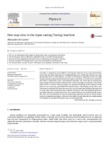Please use this identifier to cite or link to this item:
http://www.alice.cnptia.embrapa.br/alice/handle/doc/994523| Title: | One-way-ness in the input-saving (Turing) machine. |
| Authors: | CASTRO, A. de  |
| Affiliation: | ALEXANDRE DE CASTRO, CNPTIA. |
| Date Issued: | 2014 |
| Citation: | Physica A: statistical mechanics and its applications, Amsterdam, v. 415, p. 473-478, 2014. |
| Description: | Currently, a complexity-class problem is proving the existence of one-way permutations: one-to-one and onto maps that are computationally ?easy?, while their inverses are computationally ?hard?. In what follows, we make use of Bennett?s algorithm of the reversible Turing machine (quantum information heat engine) to perform a cascade of two controlled-NOT gates to physically create a permutation operation. We show that by running this input-saving (Turing) machine backwards the critical inequality of Landauer?s thermodynamic limit is reversed, which provokes the symmetry-breaking of the quantum circuit based on two successive controlled-NOT quantum gates. This finding reveals that a permutation of controlled-NOT gates becomes one-way, provided that adiabatically immersed in a heat bath, which determines the condition of existence of a thermodynamically non-invertible bijection in polynomial-time, that would otherwise be mathematically invertible. This one-way bijection can also be particularly important because it shows nonlinearities in quantum mechanics, which are detectable by watching that the mathematical reversibility of controlled-NOT gates does not work physically. |
| Keywords: | Complexidade computacional Princípio de Landauer Máquina de Turing Permutação one way Computational complexity Landauer's principle Turing machine One-way permutation |
| DOI: | 10.1016/j.physa.2014.08.021 |
| Type of Material: | Artigo de periódico |
| Access: | openAccess |
| Appears in Collections: | Artigo em periódico indexado (CNPTIA)  |
Files in This Item:
| File | Description | Size | Format | |
|---|---|---|---|---|
| onewaness.pdf | 489,5 kB | Adobe PDF |  View/Open |









